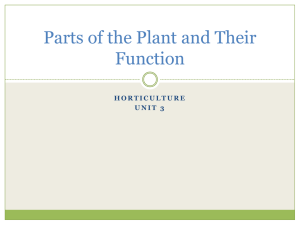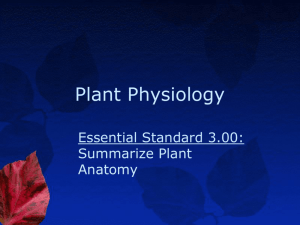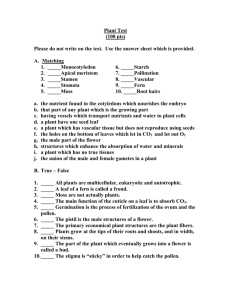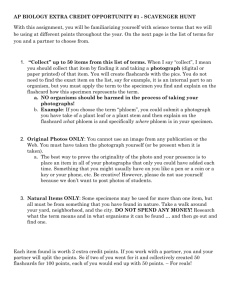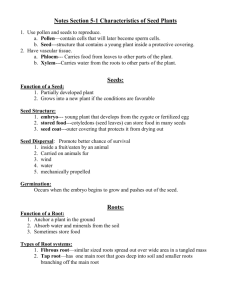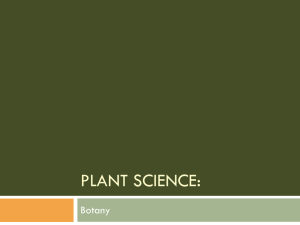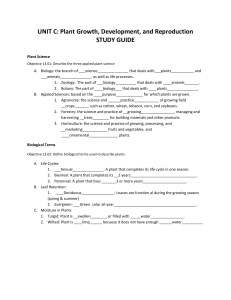Parts of the plants and Functions
advertisement
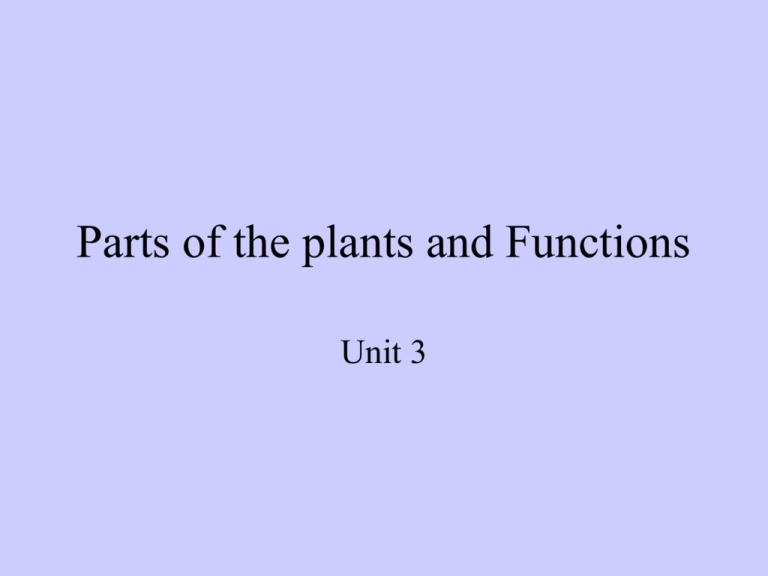
Parts of the plants and Functions Unit 3 Objective • Note 2 contributions of plants to the life cycle on earth • List and describe the purpose of the 4 main parts of plants • Explain the process of photosynthesis • Explain the major structural difference between dicot and monocot stems and how the stems grow • Describe the process of pollination Importance of Plants • Life could not exist without plants • Plants produce oxygen • Keep us cool, renew the air, slow wind, hold soil, provide home for wildlife, beautify surrounding, perfume the air, and furnish building materials and fuel Part of a plant • 4 basic parts: Leaves, stems, roots, and flowers, which become fruit or seeds Leaves • “Food factory” of the plant • Leaves vary in shape and size – Most are flat, some are needle-like, some are cylindrical • Arrangement of leaves differs – Alternate on the stem – Positioned opposite – Whorled (arranged in a circle around stem) External leaf structure • Leaves consist of the petiole (leaf stalk), and a blade (larger, flat portion of the leaf). • Leaves have veins and a midrib – Midrib is the large vein from which all other veins extend – Veins of the leaf form its structural framework Internal Leaf Structure • Epidermis (skin of the leaf) – a single layer of cells – Protects the leaf from loss of moisture – Guard cells in the epidermis open and close to allow the leaf to breathe and transpire (give off moisture and exchange gasses) • Chloroplasts – cells in the center of the leaf – Used for food making – Green color that gives the leaf that color comes from chlorophyll – Manufacture food through photosynthesis Photosynthesis • Process by which carbon dioxide and water in the presence of light are converted into sugar and oxygen • 6CO2 +6H2O + 672 kcal = C6H12O6 + 6O2 • Carbon + water + light = glucose + oxygen • A kilocalorie is the energy required to heat 1000 grams of water 1 degree C • Food manufactured by the leaves moves downward through the stem to the roots where it is used or stored Respiration • Plants respire 24 hrs a day • Consume oxygen and give off carbon dioxide • Plants produce more oxygen through photosynthesis than they consume though respiration Stems • 2 main functions • The movement of materials (water and minerals from roots or manufactured food from leaves) • Support the leaves and reproductive structures • Stems are also used for food storage and for reproduction methods that involve grafting • Green stems also manufacture food External Stem Structure • Lenticels – breathing pores on the outside of the stem • Bud scale scars – indicate where a terminal bud has been located – Distance between scars indicates 1 yr’s growth • Leaf scars – show where leaves were attached Internal stem structure • Water & minerals travel up the xylem and manufactured food travels down the phloem • Dicots – plants have 2 seed leaves – Xylem and phloem form 2 layers separated by the cambium – Stems continue to expand because cambium builds new cells on the outside of the phloem and on the inside of the xylem cells (trees) Roots • Function to… – Anchor the plant and hold it upright – Absorb water and minerals from the soil and conduct them to the stem – Store large quantities of plant food – Propagate or reproduce some plants Root Structure • Internal structure is like that of a stem • Contain xylem to carry water and minerals to the plant and phloem to carry manufactured food Root Systems • Fibrous Root systems or Tap Root systems • Fibrous Root systems – easier to transplant – Roots are shorter, smaller, and more compact • Tap Root systems – has longer and fewer roots – much of the root system is cut off when a plant is dug – Ends of the roots contain root hairs that absorb water and minerals – Larger roots store and conduct water and nutrients Flowers, Fruits and Seeds • Beauty of the flower is to attract insects – Insects help in pollination or fertilize the flower – Animals collect, eat and spread the seed Parts of the Flower • Most flowers have the same basic parts – Necessary for the production of the seed • Seed is the most common way plants reproduce in nature • Seeds are produced by sexual process involving a male and female part Complete Flower • Complete flower has both male and female parts • Contains 4 parts – Sepals – Green, leaflike parts – protect flower bud before it opens – Petal – actually leaves – generally the most striking part to attract animals and insects – Stamens – Male reproductive part – consist of a short stalk called a filament and a saclike structure on top of the filament called an anther (contains pollen) – Pistil – female part – produces eggs (ovules) – has stigma to catch pollen, style or tube leading to ovary, and ovary which becomes a fruit or seed coat



